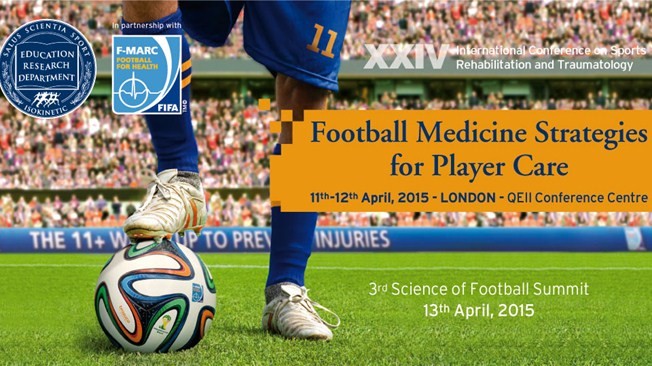Undergraduate perspective on Sports & Exercise Medicine – a BJSM blog series
By Zachary Spargo (@ZachSpargo)
After attending the Football Medicine Strategies (#FMS2015) Conference in London, I was inspired to put together a brief, yet hopefully informative overview of the streams I attended. It was a fantastic opportunity to learn, first hand, from some of the world leaders in Sport and Exercise Medicine (SEM).

What was on offer? Introduction to the conference:
The conference focused on strategies for player care and in that sense, it didn’t disappoint. After the official welcome from Dr. Peter Brukner and Dr. Stefano Della Villa, Dr. Dvorak explained the Fifa 11+ initiative and how it has led to reduced injury risk in football. This was followed by Dr Philip Batty who highlighted some current issues within sport medical teams including:
- Pressures to diagnose quickly from coaches and players
- Over reliance on scans
- Under reliance on clinical judgement
- Treat the player not the scan
- Glamour of surgery over exercise rehab
And perhaps most aptly for BJSM readers, the notion of ‘ignore exercise rehab at your peril’.
Strategies for hamstring, tendon and groin injuries:
Hamstring Injuries (P Brukner, K Thorborg, W Diesel, C Askling & M Stride)
A key message for hamstring injuries was the need for knowledge of mechanism of injury. Know the mechanism, tailor the rehab #Simple. Whether during maximal sprinting (long head of biceps femoris commonly involved), or stretching (semimembranosus involvement), this has an effect injury duration and re-injury potential. The success of the Munich consensus statement for classification of injury was highlighted. Diego Costa was hot topic also, with his recent hamstring re-injury (after only 12 days side-lined), highlighting the medical teams need to consider risk vs reward. Interestingly, hamstring injuries were shown to be on the increase. However, the research suggests an 83% non-compliance with Nordic eccentric strengthening programmes in top-level clubs, despite their proven efficacy. Food for thought!
Tendon injuries (N Maffulli, H Alfredson, K Khan, J Cook & B Knowles)
Key messages included:
- Imaging should only be used to either confirm clinical diagnosis or rule out differentials
- Little evidence for alignment issues associated with tendon injuries
- PRP has no place in rehabilitation (check @BJSM_BMJ for numerous tweets on this!)
- Mechanotransduction: the use of exercise to produce beneficial effects in tendon
- Train tendon to upper limit without pain – too much protection causes dysfunction
Groin Injuries (A Weir, M Gimpel, A Franklin-Miller, P Holmich & H Silvers)
The overall message was that the use of a dedicated prevention strategy of hip strengthening exercises could have major effects on player availability. Mo Gimpel, sports medicine and science manager at Southampton football club demonstrated just this with phenomenal player availability rates of more than 90% for past two seasons. Although this may be overemphasised with a large sized squad. You can see more of Mo Gimpel’s groin strategies at this years ACPSEM conference in October.
Functional Movement & Communication around the Player
Functional rehabilitation was the focus of the second day’s agenda. Attendees discussed deceleration, with the key points including:
- No running to be commenced before patient confident controlling fast deceleration exercises – you have to be able to slow down before you can speed up!
- ‘Stiffness’ training using a trampoline or gym bands is beneficial
- Train at 100%, not 80% in order to replicate competition
Following this there was a fantastic round table discussion which included the likes of Dr Gary O’Driscoll (Arsenal FC) and Tony Strudwick (Manchester United FC). The discussion was of high quality with regard to player confidentially and the transfer of medical notes from club to the next. Consent was stressed to be an extremely important factor – what if a player will not allow you to send details of his chronic injury to his new club for fear of contractual issues? Dr O’Driscoll highlighted the fact that there can be no excuse for not making complete and thorough medical notes even for things such as drugs administered during a busy half time period. BJSM’s very own Dr Liam West made a valid point to the discussion on the subject of player medical preference and the role of a third party medical representative to the media. Specifically, he bought up the need for us as clinicians to consider and educate ourselves on why some players wish to receive treatment from their native countries instead of using their current clubs services. One to consider there!
Football Medicine Strategies Conference 2015: In Summary
It was a brilliant event for networking, learning, and participating and one attended by many students from all over the world.
Keep your eyes out for FMS2016 in London – Definitely one for all students with a keen appetite for football medicine and SEM!
Zachary Spargo MSc Physiotherapy student (pre-registration) BSc (Hons) Sport and Exercise Science (@ZachSpargo) is currently studying at York St John University and is the Yorkshire and Humber CSP electronic communications editor for the region. He is passionate about all things Physiotherapy and SEM and is a regular footballer in his spare time.
Dr. Liam West BSc (Hons) MBBCh PGCert SEM is a junior doctor in Oxford, England. He coordinates the “Undergraduate Perspective on Sports & Exercise Medicine” Blog Series for BJSM.
If you would like to contribute to the Undergraduate Perspective on SEM BJSM Blog, please contact Dr. West at liamwestsem@hotmail.co.uk